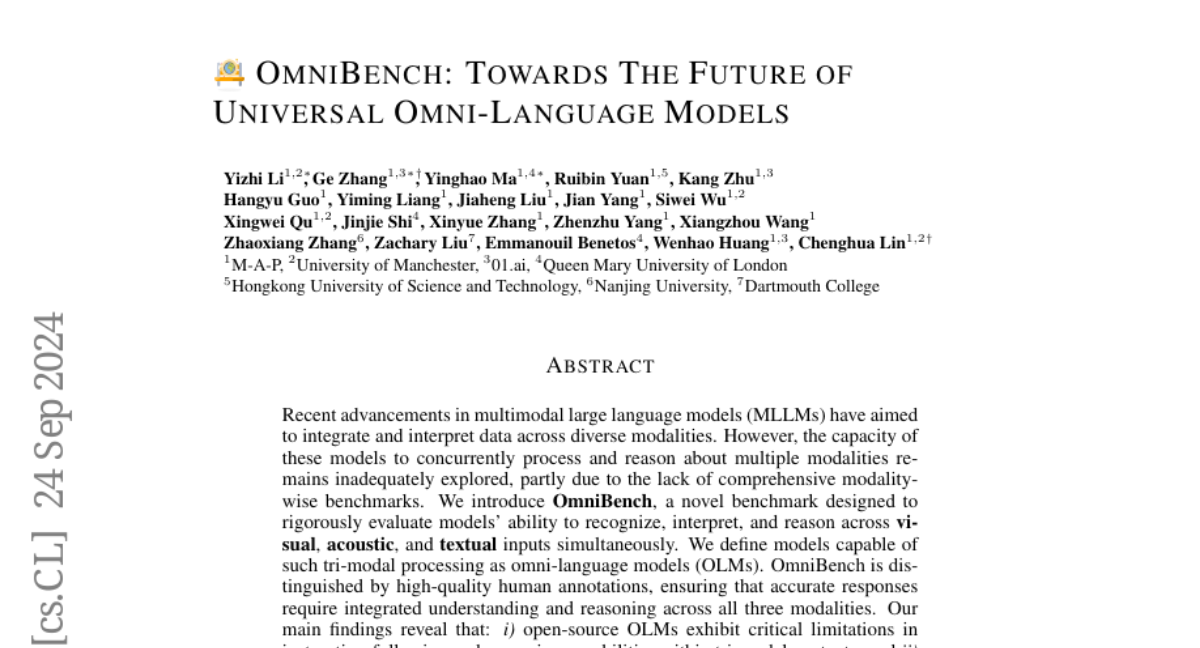OmniBench: Towards The Future of Universal Omni-Language Models
Yizhi Li, Ge Zhang, Yinghao Ma, Ruibin Yuan, Kang Zhu, Hangyu Guo, Yiming Liang, Jiaheng Liu, Jian Yang, Siwei Wu, Xingwei Qu, Jinjie Shi, Xinyue Zhang, Zhenzhu Yang, Xiangzhou Wang, Zhaoxiang Zhang, Zachary Liu, Emmanouil Benetos, Wenhao Huang, Chenghua Lin
2024-09-25

Summary
This paper introduces OmniBench, a new benchmark designed to evaluate how well large language models (LLMs) can understand and reason with information from different types of inputs, including text, images, and sounds. It aims to improve the capability of these models to process multiple forms of information at once.
What's the problem?
While there have been advancements in multimodal large language models that can handle different types of data, their ability to work with visual, acoustic, and textual information together has not been thoroughly tested. Existing benchmarks do not adequately assess how well these models can integrate and reason about information from all three modalities simultaneously. This lack of evaluation limits our understanding of their true capabilities.
What's the solution?
To address this issue, the researchers created OmniBench, which includes high-quality human annotations to ensure that the models are evaluated on their ability to understand and reason across all three types of inputs. They found that many open-source omni-language models struggle with following instructions and reasoning correctly when dealing with combined inputs. The study also revealed that most models performed poorly when asked to interpret alternative text representations of images and audio.
Why it matters?
This research is significant because it highlights the need for better training methods and evaluation techniques for multimodal language models. By providing a comprehensive benchmark like OmniBench, researchers can identify weaknesses in current models and guide future developments towards creating more robust systems that can effectively process and reason about information from multiple sources. This advancement could lead to more intelligent AI systems capable of understanding complex real-world scenarios.
Abstract
Recent advancements in multimodal large language models (MLLMs) have aimed to integrate and interpret data across diverse modalities. However, the capacity of these models to concurrently process and reason about multiple modalities remains inadequately explored, partly due to the lack of comprehensive modality-wise benchmarks. We introduce OmniBench, a novel benchmark designed to rigorously evaluate models' ability to recognize, interpret, and reason across visual, acoustic, and textual inputs simultaneously. We define models capable of such tri-modal processing as omni-language models (OLMs). OmniBench is distinguished by high-quality human annotations, ensuring that accurate responses require integrated understanding and reasoning across all three modalities. Our main findings reveal that: i) open-source OLMs exhibit critical limitations in instruction-following and reasoning capabilities within tri-modal contexts; and ii) the baseline models perform poorly (below 50% accuracy) even when provided with alternative textual representations of images and audio. These results suggest that the ability to construct a consistent context from text, image, and audio is often overlooked in existing MLLM training paradigms. We advocate for future research to focus on developing more robust tri-modal integration techniques and training strategies to enhance OLM performance across diverse modalities. The codes and live leaderboard could be found at https://m-a-p.ai/OmniBench.